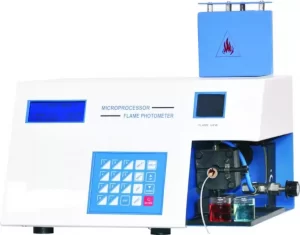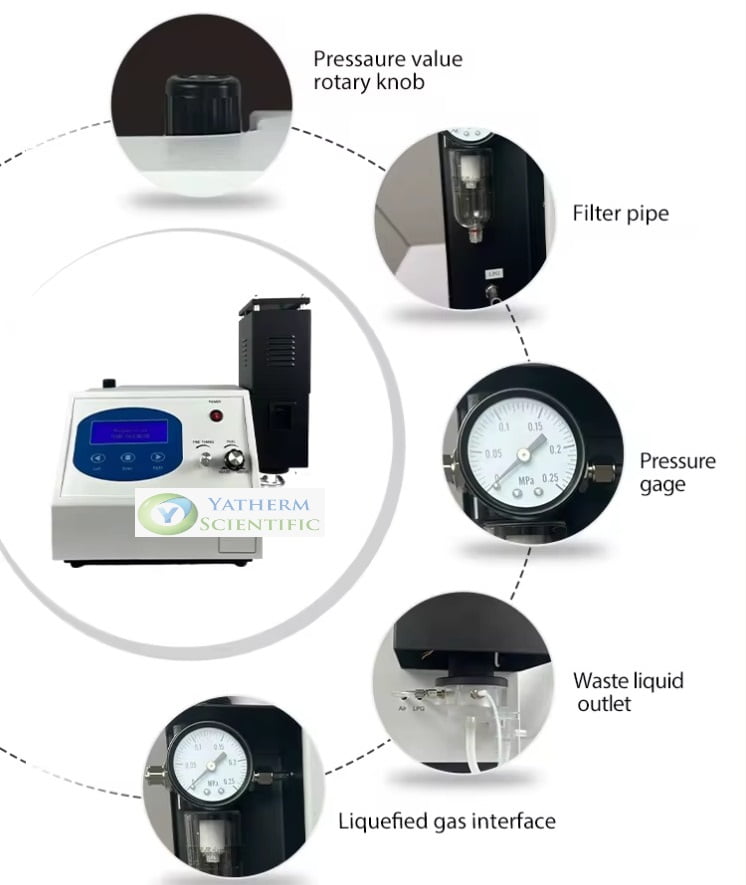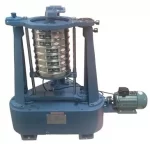FLAME PHOTOMETER
Multi-parameter flame photometer Heavy Metal Detection/Flame photometer with K, Na, Li, Ca, Ba

Flame photometry is the simplest of analytical techniques based on atomic spectroscopy. In this case, the sample containing metallic cations is inserted into a flame and analyzed for the amount of radiation emitted by the excited atomic or ionic species. The elements, upon receiving energy from a flame, generate excited species that, upon returning to the ground state, release part of the energy received in the form of radiation, at characteristic wavelengths for each chemical element. The flame photometer is the equipment used to perform different types of laboratory analyses. The product is always used on a large scale and, therefore, is essential for several sectors.
Despite the simplicity of the technique, several important concepts are involved in the development of experiments using flame photometry, from the principles of spectroscopy to statistics in data treatment, including sample preparation and elimination of interference. The manipulation of chemical elements requires a series of equipment suitable for this function, in order to promote the precise results expected and the safety of the operators, thus, in many cases the use of the flame photometer is applicable.
The flame photometer is equipment to analyze the proper dosage of some specific reagents contained in samples, Sodium (Na) and Potassium (K), and it can also include Calcium (Ca) and Lithium (Li). This observation occurs through the colors that each chemical element is capable of emitting when in contact with a non-luminous flame. Flame photometer for applications in food, cellulose, whey, beverages, soil, ore, human saliva, vinasse, and fuels.
Yatherm Scientific is a leading firm, with excellence in the area of analytical instrumentation, and products with maximum quality for both laboratory and field activities. The Yatherm Scientific Company offers and operates in several segments, producing standard solutions for pH, conductivity, and even flame photometers. In addition, among its other actions, it also offers technical assistance and maintenance of instruments. With several years of proven experience in the industry, Yatherm Scientific is a company specializing in trade and calibration, and maintenance services for laboratory devices.
Applications
- Cement industry
- Fertilizers & Soil Testing
- Petroleum and Metallurgy
- Pharmaceutical and food testing
- Solid Waste Treatment
- Chemical product testing
- Glass, Ceramics & Refractories Manufacturing industry
Flame Photometer Working Principle
Feature

- Printing Port
- Easy to use
- works on LPG cylinder
- Flame selection
- Lesser Faults
- PMT detector.
- PPS spray chamber for higher stability
- Higher Reliability
- Rich experience in AAS product manufacturing
- Stable performance
- Microprocessor-based controlling for easy operation and maintenance
- Reliable gas-liquid separator
- Higher Safety
- Modular gas supply system provides higher safety and reliability.
- Safety Interlocking system
- The mass flow controller controls the fuel flow precisely.
- Temperature controlling & circuit breaker
Specifications
| Model | General | Serum | Urine |
| Range | Na: 0 – 100 ppm Upto 250 meq/l, 1:100 dil K: 0 – 100 ppm Upto 250 meq/l, 1:100 dil Ca: 0 – 100 ppm Upto 250 meq/l, 1:100 dil Li: 0 – 100 ppm Upto 250 meq/l, 1:100 dil Ba: 50-1000 |
Na: 0 – 200 1:100 dil K: 0 – 10 1:100 dilute – Li: 0 – 2 1:5 dil |
Na: 0 – 250 1:100 dil K: 0 – 100 1:100 dil Ca: 0 – 10 1:2 dil – |
| Sensitivity | General: Na: 0.5 ppm, K: 0.5 ppm, Li: 0.5 ppm, Ca: 15 ppm, Ba : 50 ppm | ||
| Filters | Na & K supplied (Ca & Li are optional at extra cost) | ||
| Resolution | 0.1 ppm/meq | ||
| Reproducibility | < 1% coefficient of variation for 20 consecutive samples using 10 ppm Na set as the maximum standard | ||
| Curve Fit Accuracy | < 2% error when 3 ppm Na/K and 5 ppm Li are set as maximum standards | ||
| Display | 20 x 4 alphanumeric LCD with backlit | ||
| Average Time | In-built software | ||
| Flame System | LPG and dry oil-free air | ||
| Detector | Silicon photodiode | ||
| Calibration | with up to 25 Standards of User Choice with Curve Fitting Software (5 for each Element) Multiple Calibration Curves can be stored in the memory |
||
| Gas Control | Adjustable with knobs | ||
| Flame Failure | Auto-detection | ||
| Gas Cutoff | Automatic | ||
| Ignition System | Autoignition | ||
| Atomizer | Axial flow type | ||
| Printer | Provision for attachment of dot matrix printer or HP laserjet/ inkjet (non-windows) printers with Centronics parallel interface | ||
| RS-232C | Available (PC software optional) | ||
| Power | 230 V ± 10% AC, 50 Hz | ||
| Dimensions | 285 x 255 x 210 mm (L x B x H) | ||
| Weight | 7.5 Kg | ||
| COMPRESSOR UNIT | |||
| Air Supply | Oil-free mini compressor unit with a pressure regulator | ||
| Combustion Gas | LPG controlled by a precision regulator | ||
| Power | 230 V ± 10% AC, 50 Hz | ||
| Dimensions | 290 x 255 x 210 mm (L x B x H) | ||
| Weight | 8 Kg | ||
FLAME PHOTOMETER MODELS:
Yatherm Scientific provides some flame photometer models, each with the proper specifications. However, just as there are different points, in some of them there are also some in common. Flame photometer can be done at up to five selectable points and you can store the read data. In addition, it allows the linearization of the working curve and simultaneous readings of Na, K, Ca, Li, and Ba. Yatherm Scientific’s flame photometer has some details in common, such as:
- Stability indicator;
- Automatically calibrated parameters;
- Non-volatile memory system: prevents programming from being lost when the device is switched off;
- The option of the flame to be turned off in the moment of power failure;
- Automatic purge in the air filter;
- Manometer (analog pressure indicator);
- Dismountable mixing system for easy maintenance and;
- The automatic ignition system for ignition.
Standard Working conditions
- The flame photometer should be placed in a ventilated room on a stable table
- Power Supply 220v ±10% Frequency 50/60 hz
- Electric Load – 30W
- Ambient temperature range – 10 ~ 37 ℃.
- Relative humidity ≤ 80%.
- Built-in steel plate with epoxy coating, the flame photometer has a long service life and is equipment that does not require constant maintenance, which makes it a great investment.
- Another positive point of the flame photometer is its easy handling. The product shows all information through a graphic display, which allows direct reading. Another factor that facilitates its use is the automatic zero and concentration calibration.
- The equipment has an audible signal for each function and is equipped with membrane-type keys that bring greater dynamics to work operations. The flame photometer also has a compact sample atomization system and an efficient air drying system.
- The most important components of the flame photometer are the internal filter for each element, its double insulated power cable, and also the 3-pin plug. It is worth noting that the equipment must be produced in accordance with regulatory standards so that it can operate with maximum efficiency.
If you have any questions about the flame photometer and how it works? Get in touch with our Experts or contact us. Let one of our experts help!




